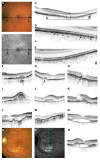Angioid Streaks Remain a Challenge in Diagnosis, Management, and Treatment
- PMID: 38535759
- PMCID: PMC10976272
- DOI: 10.3390/vision8010010
Angioid Streaks Remain a Challenge in Diagnosis, Management, and Treatment
Abstract
Aim: Angioid streaks (ASs) are a rare retinal condition and compromise visual acuity when complicated with choroidal neovascularization (CNV). They represent crack-like dehiscences at the level of the Bruch's membrane. This objective narrative review aims to provide an overview of pathophysiology, current treatment modalities, and future perspectives on this condition. Materials and Methods: A literature search was performed using "PubMed", "Web of Science", "Scopus", "ScienceDirect", "Google Scholar", "medRxiv", and "bioRxiv." Results: ASs may be idiopathic, but they are also associated with systemic conditions, such as pseudoxanthoma elasticum, hereditary hemoglobinopathies, or Paget's disease. Currently, the main treatment is the use of anti-vascular endothelial growth factors (anti-VEGF) to treat secondary CNV, which is the major complication observed in this condition. If CNV is detected and treated promptly, patients with ASs have a good chance of maintaining functional vision. Other treatment modalities have been tried but have shown limited benefit and, therefore, have not managed to be more widely accepted. Conclusion: In summary, although there is no definitive cure yet, the use of anti-VEGF treatment for secondary CNV has provided the opportunity to maintain functional vision in individuals with AS, provided that CNV is detected and treated early.
Keywords: Bruch’s membrane; Paget’s disease; aflibercept; angioid streaks; bevacizumab; brolucizumab; faricimab; hemoglobinopathies; peau d’orange; pseudoxanthoma elasticum; ranibizumab.
Conflict of interest statement
The authors declare no conflicts of interest.
Figures






References
-
- Kanski J. Clinical Ophthalmology: A Systematic Approach. 8th ed. Elsevier; Amsterdam, The Netherlands: 2015.
-
- Doyne R.W. Choroidal and retinal changes. The results of blows on the eyes. Trans. Ophthalmol. Soc. UK. 1889;9:128.
-
- Plange O. Über streifenförmige Pigmentbildung mit sekundären Veränderungen der Netzhaut infolge von Hämorrhagien. Arch. Augenheilkd. 1891;23:78–90.
Publication types
LinkOut - more resources
Full Text Sources
Research Materials
Miscellaneous

